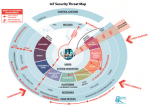Last week NMI hosted the IoT Security Summit at the home of the code breakers – Bletchley Park.
As we explained previously
Of course, it isn’t possible to cover every facet in one sitting, however we did cover much of the landscape from the national interests and opportunities, applicable cryptography, case study examples of hacks and attacks (consumer, automotive and beyond), views from the chip, software and mobile operator perspectives. All this before finishing up with a panel discussion which included Europe’s first cyber-security accelerator; CyLon.

Reducing the attack surface was part of the mantra of the day – which is where I have taken inspiration for the title of this blog post: not only does security need to be layered (enter the onion), it also needs to be segmented (enter the orange) and then sliced (enter the bread – anybody have better food themed suggestions?). In this way, conceptually at least, vulnerabilities can be reduced.

With trust as a central theme, a good number of recommendations and ideas came forth during the proceedings – especially how we (industry, customers and all other stakeholders) all might work together to progress the robustness and quality of IoT systems. Whilst ideas are a good starting point, action is desired hence we asked the question:
Should NMI assemble a group of interested parties to identify and take next steps to address the priority issues raised today?
The votes are now in and counted – I am pleased to say that 97% of respondents voted yes (and in the interest of disclosure I will add a caveat that 2 of those voting suggested it would only be a yes if something tangible came from the group).
So there you have it – watch this space – we will be working with this new community to determine what is right and proper for NMI to help in liberating the IoT.
[Copies of the talks and presentation materials will also be available to attendees and members on this website shortly.]
Article by John Moor, VP New Segment Development, NMI
[dcwsb inline=”true”]
